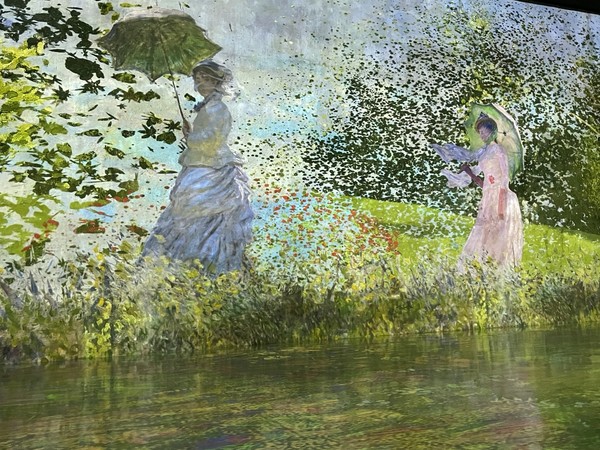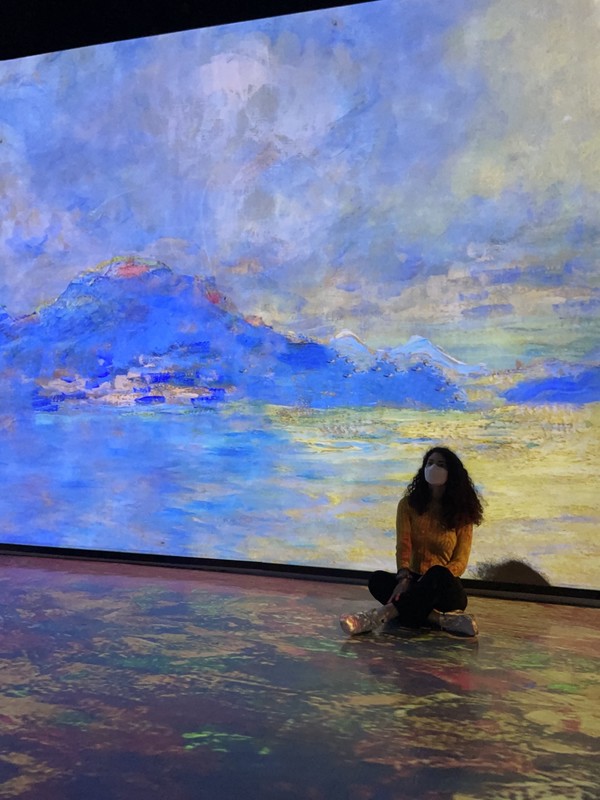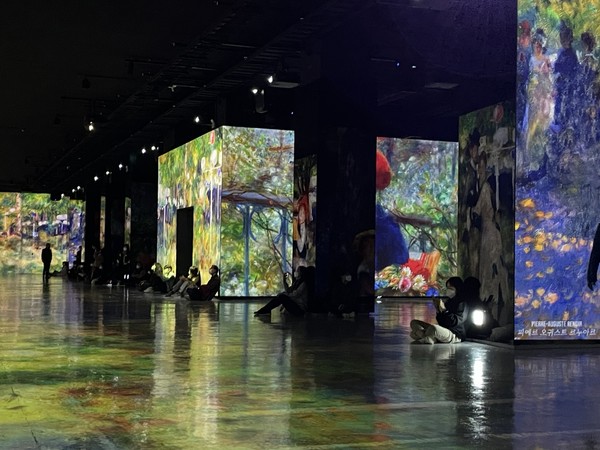Inside the Bunker de Lumières


“GETTING LOST inside a canvas” does not have to be taken figuratively. On the eastern side of Jeju, the Bunker de Lumières is a mediatic exhibit that projects the works of the greatest artists. Their masterpieces come to life in front, behind, and even underneath its viewer. Part of the larger “Lumières” project, the exhibit has affiliated spaces in France. The “Lumières” project aims to provide a new way to revisit famous artworks.
From impressionism to modernism
The Bunker de Lumière’s current exhibit “Monet, Renoir…Chagall” takes visitors on a walk through the intricate masterpieces of impressionists and the free-flowing spirit of modernists. Impressionism is a 19th century French artistic movement that defied the neoclassical[1] trends of its time. Characterized by small and thin brushstrokes, impressionists aimed to capture the human experience through accurate depictions of light and movement but with little intention to paint a photograph of reality. During the late 19th and early 20th century, modernists followed in the footsteps of impressionists. Modernists strived to break through the artistic boundaries of shape and form by rejecting conventional artistic norms such as picture-like renditions of life and exploring new perceptions of art. The exhibit mirrors the artist’s attempts to create new art, re-exploring old works and reviving them in the 21st century. In an interview with The Yonsei Annals, Kim Hyunjung, the bunker’s business manager, said the Bunker de Lumières “embodies a new immersive form of art, allowing our audience to experience artworks which are scattered across the world in a single space.”
The video program, “Monet, Renoir… Chagall,” centers around the works of Monet, Renoir, and Chagall—chefs de file[2] of impressionism and modernism, respectively. Monet’s most renowned works are Bridge over a Pond of Water Lilies and Women with a Parasol, both painting colorful depictions of nature. Accompanying Monet is Renoir, known for his lively portrayals of the 19th century bourgeoisie, shown for example in The Swing. Alongside the two impressionists, the exhibit also highlights the works of Chagall, an early and key modernist whose works, such as Paris through the window, are known to be abstract pieces filled with color and emotion. In addition to Monet, Renoir, and Chagall, the exhibit showcases the works of multiple artists, expanding to other artistic movements such as pointillism, neo-impressionism, fauvism, and cubism. Bunker de Lumières expands beyond traditional boundaries of art by using digital media to revitalize old masterpieces.


Walking inside a canvas
Few exhibitions manage to transport their audience inside an artist’s world, but the bunker successfully executes this difficult task. The exhibit’s open space allows the audience to explore, taking different paths as they walk through the spectacle of lights. Lasting a total of 35 minutes, the program is organized in six video sequences, each presenting cinematographic reinterpretations of 19th and 20th century masterpieces.
The exhibit does not stop at simply displaying a static image of the artworks but breathes life and movement into them. The masterpieces are deconstructed, separating the background from the foreground. The backgrounds become dynamic, slowly flowing from wall to wall. Each wall has different projections of the foreground, and some showcase an active scene while others set the foreground aside—to capture all the details, the audience needs continually move back and forth during the exhibit. The program is accompanied by musical compositions perfectly matched to each video sequence, complimenting the energy of the pieces. Rich melodies accompany vibrant and colorful paintings, while mellow harmonies complement more muted works. For example, scenes of the bourgeoisie are accompanied by funky jazz, such as singer Billie Holiday’s single “All of me,” while the nostalgic classical piano piece, “Suite bergamasque, L.75: III. Clair de lune,” accompanied softer artworks of nature.

“Revival”
The bunker was initially built as a secret government facility for communications between Korea and Japan during the 1980s, making it sound and lightproof. Hidden in the “Oreum volcanic cone,” the site had been abandoned until 2017, when it proved perfect for the “Lumières” project. Kim said, “It was challenging to find a place in Korea that fulfilled the project’s width and height requirements. We looked everywhere and ended up choosing this old bunker.” After a year of renovation, the bunker was ready to house an exhibit. New walls, mirror rooms, and beam projectors were installed—all to create the best space to utilize light and depth to truly captivate its audience.
The bunker is also an example of successful planned urban regeneration[3]. “Our exhibition aimed to showcase artistic masterpieces, accompanied by music […] in a place left behind by industrialization, one forgotten in our memories,” said Kim, illustrating how the “Lumière” project repurposed the abandoned facility without ruining the surrounding nature and created a “new asset” for the rural area. The newly built exhibit gave the area an economic boost, as it attracted both local and international tourists. Kim adds, “While it is true that we had high hopes for the exhibit’s success, the first exhibit the bunker presented, Bunker de Lumières: Klimt, widely surpassed our expectations, with over 560,000 visitors during its showcase.” With a new artistic theme each year, the bunker has established itself as an integral cultural and artistic landmark in Jeju Island.
* * *
The Bunker de Lumières created an opportunity for visitors to discover pieces from all around the world in a bunker in rural Jeju. By breathing new life into the facility, the project revitalized the area, turning it into a major attraction. The exhibit uses the bunker’s structure to heighten the audience’s experience, transporting them directly into the 19th and 20th century mediatic scene.
Period: “Monet, Renoir…Chagall” April 23, 2021, to Feb. 28, 2022.
Entry Hours: 10:00-19:00 (April - September, last entry 6 p.m.) 10:00-18:00 (October to March, last entry 5 p.m.)
Admission: Adults ₩20,000
Address: Bunker de Lumières (2039-22), Goseong-ri, Seongsan-eup, Seogwipo-si, Jeju Special Self-Governing Province
[1] Neoclassicism: Cultural and artistic movement inspired by classical antiquity
[2] Chef de file: French word, leading personality of a movement or cause.
[3] Urban renewal: A program of land redevelopment to improve the cultural, social, and economic status of an area.

